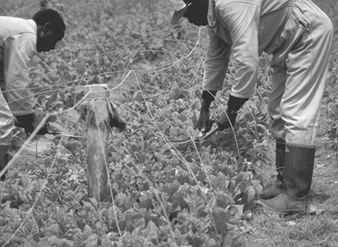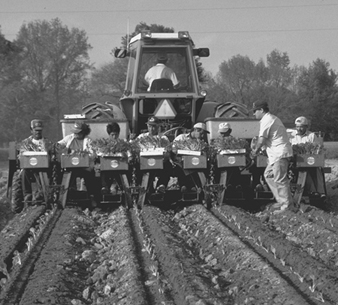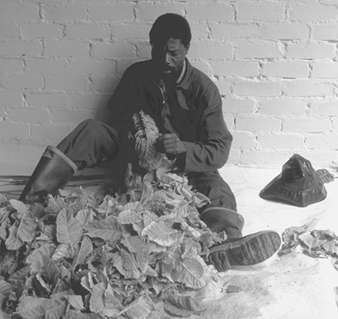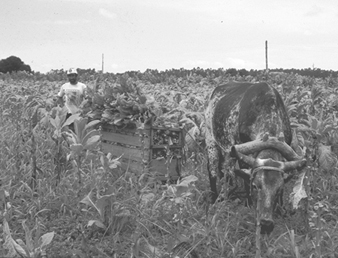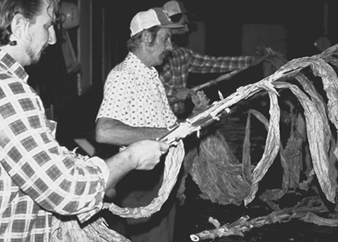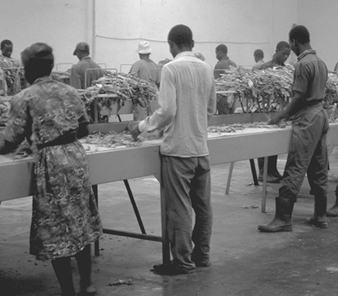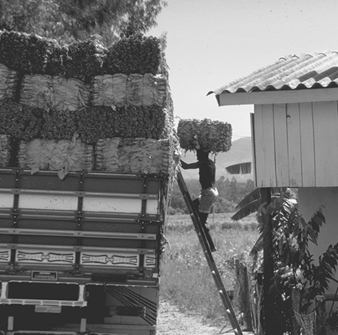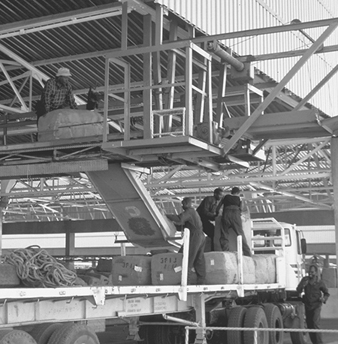Peedin, Gerald F.
Address: North Carolina State University, Crop Science Department, Box 7620, Raleigh, NC 27695
Country: United States
Phone: 1 (919) 515-4058
Fax: 1 (919) 515-7959
E-mail: gpeedin@wolf.ces.ncsu.edu
Education: PhD
Tobacco Cultivation
Tobacco (Nicotiana tabacum) is a unique plant with its characteristic commercial component, nicotine, contained in its leaves. Although cotton is grown on more surface area, tobacco is the most widely grown nonfood crop in the world; it is produced in approximately 100 countries and on every continent. Tobacco is consumed around the world as cigarettes, cigars, chewing or smoking tobaccos and snuff. However, over 80% of world production is consumed as cigarettes, currently estimated at nearly 5.6 trillion annually. China, the United States, Brazil and India produced over 60% of total world production in 1995, which was estimated at 6.8 million tonnes.
The specific uses of tobacco by manufacturers are determined by the chemical and physical properties of the cured leaves, which in turn are determined by interactions among genetic, soil, climatic and cultural management factors. Therefore, many kinds of tobacco are grown in the world, some with rather specific local, commercial uses in one or more tobacco products. In the United States alone, tobacco is categorized into seven major classes which contain a total of 25 different tobacco types. The specific techniques used to produce tobacco vary among and within tobacco classes in various countries, but cultural manipulation of nitrogen fertilization, plant density, time and height of topping, harvesting and curing are used to favourably influence the usability of the cured leaves for specific products; quality of leaves, however, is highly dependent on prevailing environmental conditions.
Flue-cured, Burley and Oriental tobaccos are the major components of the increasingly popular blended cigarette now consumed worldwide, and represented 57, 11 and 12%, respectively, of world production in 1995. Thus, these tobaccos are widely traded internationally; the United States and Brazil are the major exporters of flue-cured and Burley leaf tobaccos, while Turkey and Greece are the major world suppliers of Oriental tobacco. The world’s largest tobacco producer and cigarette manufacturer, China, currently consumes most of its production internally. Because of increasing demand for the “American” blended cigarette, the United States became the major cigarette exporter in the early 1990s.
Tobacco is a transplanted crop. In most countries, seedlings are started from tiny seeds (about 12,000 per gram) sown by hand on well-prepared soil beds and manually removed for transplanting to the field after reaching a height of 15 to 20 cm. In tropical climates, seed-beds are usually covered with dried plant materials to preserve soil moisture and reduce disturbance of seeds or seedlings by heavy rains. In cooler climates, seed-beds are covered for frost and freeze protection with one of several synthetic materials or with cotton cheesecloth until several days before transplanting. The bed sites are usually treated before seeding with methyl bromide or dazomet to manage most weeds and soil-borne diseases and insects. Herbicides for supplemental grass management are also labelled for use in some countries, but in areas where labour is plentiful and inexpensive, weeds and grasses are often removed by hand. Foliar insects and diseases are usually managed with periodic applications of appropriate pesticides. In the United States and Canada, seedlings are produced primarily in greenhouses covered with plastic and glass, respectively. Seedlings are usually grown in peat- or muck-based media which, in Canada, are steam-sterilized before seeds are sown. In the United States, polystyrene trays are predominantly used to contain the media and are often treated with methyl bromide and/or a chlorine bleach solution between transplant production seasons to protect against fungal diseases. However, only a few pesticides are labelled in the United States for use in tobacco greenhouses, so farmers there depend substantially on proper ventilation, horizontal air movement and sanitation to manage most foliar diseases.
Regardless of the method of transplant production, seedlings are periodically clipped or mowed above the apical meristems for several weeks before transplanting to improve uniformity and survival after transplanting to the field. Clipping is performed mechanically in some developed countries but manually where labour is plentiful (see figure 1).
Figure 1. Manual clipping of tobacco seedlings with shears in Zimbabwe
Gerald Peedin
Depending on availability and cost of labour and equipment, seedlings are manually or mechanically transplanted to well- prepared fields previously treated with one or more pesticides for control of soil pathogens and/or grasses (see figure 2). In order to protect workers from pesticide exposure, pesticides are seldom applied during the transplanting operation, but additional weed and foliar pest management are often needed during subsequent growth and harvesting of the crop. In many countries, varietal tolerance and 2- to 4-year rotations of tobacco with nonhost crops (where sufficient land is available) are widely used to reduce reliance on pesticides. In Zimbabwe, government regulations require seedling beds and stalks/roots in harvested fields to be destroyed by certain dates to reduce the incidence and spread of insect-transmitted viruses.
Figure 2. Mechanical transplanting of flue-cured tobacco in North Carolina (US)
About 4 to 5 hectares per day can be transplanted using ten workers and a four-row transplanter. Six workers are needed for a two-row transplanter and four workers for a one-row transplanter.
Gerald Peedin
Depending upon tobacco type, fields receive relatively moderate-to-high rates of fertilizer nutrients, which are usually applied by hand in developing countries. For proper ripening and curing of flue-cured tobacco, it is necessary for nitrogen absorption to decrease rapidly soon after vegetative growth is complete. Therefore, animal manures are not routinely applied to flue-cured soils, and only 35 to 70 kg per hectare of inorganic nitrogen from commercial fertilizers are applied, depending on soil characteristics and rainfall. Burley and most chewing and cigar tobaccos are usually grown on more fertile soils than those used for flue-cured tobacco, but receive 3 to 4 times more nitrogen to enhance certain desirable characteristics of these tobaccos.
Tobacco is a flowering plant with a central meristem which suppresses growth of axillary buds (suckers) by hormonal action until the meristem begins to produce flowers. For most tobacco types, removal of flowers (topping) before seed maturation and control of subsequent sucker growth are common cultural practices used to improve yields by diverting more growth resources into leaf production. Flowers are removed manually or mechanically (primarily in the United States) and sucker growth retarded in most countries with applications of contact and/or systemic growth regulators. In the United States, suckercides are applied mechanically on flue-cured tobacco, which has the longest harvest season of the tobacco types produced in that country. In underdeveloped countries, suckercides are often applied manually. However, regardless of the chemicals and application methods used, complete control is seldom achieved, and some hand labour is usually needed to remove suckers not controlled by the suckercides.
Harvesting practices vary substantially among tobacco types. Flue-cured, Oriental and cigar wrapper are the only types whose leaves are consistently harvested (primed) in sequence as they ripen (senesce) from the bottom to the top of the plant. As leaves ripen, their surfaces become textured and yellow as chlorophyll degrades. Several leaves are removed from each plant in each of several passes over the field during a period of 6 to 12 weeks after topping, depending on rainfall, temperature, soil fertility and variety. Other tobacco types such as Burley, Maryland, cigar binder and filler, and fire-cured chewing tobaccos are “stalk cut”, meaning that the entire plant is cut off near ground level when most of the leaves are judged to be ripe. For some air-cured types, the lower leaves are primed while the remainder of the plant is stalk cut. Regardless of tobacco type, harvesting and preparation of the leaves for curing and marketing are the most labour-intensive tasks in tobacco production (see figure 3).Harvesting is normally accomplished with manual labour, especially for stalk cutting, which has yet to be totally mechanized (see figure 4). Priming of flue-cured tobacco is now highly mechanized in most developed countries, where labour is scarce and expensive. In the United States, about one-half of the flue-cured type is primed with machines, which requires almost complete weed and sucker control to minimize content of these materials in the cured leaves.
Figure 3. Preparing Oriental tobacco for air-curing soon after hand harvesting
The small leaves are collected on a string by pushing a needle through the central vein of each leaf.
Gerald Peedin
Figure 4. Hand harvesting of flue-cured tobacco by a small farmer in southern Brazil
Some farmers use small tractors rather than oxen to pull sleds or trailers. Over 90% of harvesting and other labour is provided by family members, relatives and/or neighbours.
Gerald Peedin
Proper curing of most tobacco types requires management of temperature and moisture content within the curing structure to regulate the drying rate of green leaves. Flue-curing requires the most sophisticated curing structures because temperature and moisture control follow rather specific schedules, and temperatures reach over 70 °C in the latter stages of curing, which totals only 5 to 8 days. In North America and Western Europe, flue-curing is accomplished primarily in gas- or oil-fired metal (bulk) barns equipped with automatic or semiautomatic temperature- and humidity-control devices. In most other countries, the barn environment is controlled manually and the barns are constructed of wood or bricks and often fired by hand with wood (Brazil) or coal (Zimbabwe). The initial and most important stage of flue-curing is called yellowing, during which chlorophyll is degraded and most carbohydrates are converted to simple sugars, giving cured leaves a characteristic sweet aroma. The leaf cells are then killed with drier and hotter air to stop respiratory losses of sugars. The products of combustion do not contact the leaves. Most other tobacco types are air-cured in barns or sheds without heat, but usually with some means of partial, manual ventilation control. The air-curing process requires 4 to 8 weeks, depending on prevailing environmental conditions and the ability to control humidity within the barn. This longer, gradual process results in cured leaves with low sugar contents. Fire-cured tobacco, used primarily in chewing and snuff products, is basically air-cured but small, open fires using oak or hickory wood are used to periodically “smoke” the leaves to give them a characteristic wood odour and taste and to improve their keeping properties.
The colours of cured leaves and their uniformity within a lot of tobacco are important characteristics used by buyers to determine the usefulness of tobaccos for specific products. Therefore, leaves with undesirable colours (particularly green, black and brown) are usually manually removed by farmers before offering the tobacco for sale (see figure 5).In most countries, the cured tobaccos are further separated into homogeneous lots based on variations in leaf colour, size, texture and other visual characteristics (see figure 6).In some southern African countries, where labour is plentiful and inexpensive and most of the production is exported, a crop may be sorted into 60 or more lots (i.e., grades) before being sold (as in figure 6).Most tobacco types are packaged in bales weighing 50 to 60 kg (100 kg in Zimbabwe) and delivered to the purchaser in the cured form (see figure 7).In the United States, flue-cured tobacco is marketed in burlap sheets averaging about 100 kg each; however, use of bales weighing over 200 kg is currently being evaluated. In most countries, tobacco is produced and sold under contract between the farmer and the purchaser, with predetermined prices for the various grades. In a few large tobacco-producing countries, annual production is controlled by government regulation or by farmer-buyer negotiation, and the tobacco is sold in an auction system with (United States and Canada) or without (Zimbabwe) minimum established prices for the various grades. In the United States, flue-cured or Burley tobacco not sold to commercial buyers is purchased for price support by grower-owned cooperatives and sold later to domestic and foreign buyers. Although some marketing systems have been substantially mechanized, such as that in Zimbabwe (shown in figure 8),.a great deal of manual labour is still required to unload and present the tobacco for sale, remove it from the sale area and load and transport it to the buyer’s processing facilities.
Figure 5. Manual removal of cured Burley leaves from the stalks
Gerald Peedin
Figure 6. Manual separation of cured flue-cured tobacco into homogeneous grades in Zimbabwe.
Gerald Peedin
Figure 7. Loading tobacco bales for transport from the farm to a marketing centre in southern Brazil
Gerald Peedin
Figure 8. Unloading a farmer’s tobacco bales at the auction centre in Zimbabwe, which has the most mechanized and efficient flue-cured marketing system in the world.
Gerald Peedin
Hazards and Their Prevention
The manual labour required to produce and market tobacco varies greatly around the world, depending primarily on the level of mechanization used for transplanting, harvesting and market preparation. Manual labour involves risks of musculoskeletal problems from activities such as transplanting seedlings, application of suckercides, harvesting, separation of the cured tobacco into grades and lifting of tobacco bales. Training in proper lifting methods and provision of ergonomically designed tools can help prevent these problems. Knife injuries may occur during cutting, and tetanus may arise in open wounds. Sharp, well-designed knives and training in their use can reduce the number of injuries.
Mechanization can reduce these risks, but carries risks of injury from the machinery used, including transportation accidents. Well-designed tractors with safety cabs, properly guarded machinery and adequate training can reduce the number of injuries.
Spraying of pesticides and fungicides can involve the risk of chemical exposures. In the United States, the Environmental Protection Administration (EPA) Worker Protection Standard requires farmers to protect workers from pesticide-related illness or injury by (1) providing training on pesticide safety, specifically those pesticides used on the farm; (2) providing personal protective equipment (PPE) and clothing and assuming responsibility for their proper use and cleaning, plus ensuring that workers do not enter treated fields during specific time intervals after pesticide application; and (3) providing decontamination sites and emergency assistance in case of exposure. Substitution of less hazardous pesticides should also be done where possible.
Field labourers, usually those not accustomed to working in tobacco fields, sometimes become nauseous and/or dizzy soon after direct contact with green tobacco during harvesting, perhaps because nicotine or other substances are absorbed through the skin. In the United States, the condition is called “green tobacco sickness” and affects a small percentage of workers. Symptoms occur most often when sensitive individuals are harvesting wet tobacco and their clothing and/or exposed skin is in almost continuous contact with green tobacco. The condition is temporary and not known to be serious, but causes some discomfort for several hours after exposure. Suggestions for sensitive workers to minimize exposure during harvesting or other tasks requiring prolonged contact with green tobacco include not starting work until the leaves have dried or wearing lightweight rain gear and waterproof gloves when the leaves are wet; wearing long trousers, long-sleeve shirts and possibly gloves as precautions when working in dry tobacco; and leaving the field and washing immediately if symptoms occur.
Skin diseases may occur in workers handling tobacco leaf in warehouses or barns. Sometimes workers in these storage areas, especially new workers, may develop conjunctivitis and laryngitis.
Other preventive measures include good washing and other sanitary facilities, provision of first aid and medical care, and proper training.
" DISCLAIMER: The ILO does not take responsibility for content presented on this web portal that is presented in any language other than English, which is the language used for the initial production and peer-review of original content. Certain statistics have not been updated since the production of the 4th edition of the Encyclopaedia (1998)."

